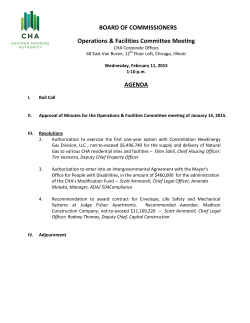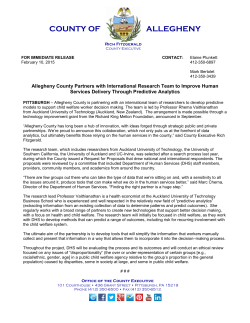
Partnering for Progress
Partnering for Progress Accelerating the Development of Social and Affordable Housing at Scale in New Zealand NZ Council for Infrastructure Development Community Housing Aotearoa 15 April 2015 Sarah Lang Manager Social Infrastructure Portfolio, NZCID AGENDA 3.30pm 3.35pm 3.45pm 3.55pm 4.10pm 5.15pm 5.45pm 6.00pm Welcome – Graeme Roberts, Director, Beca Introduction – John Rae, Chairman, NZCID Scene setting – Stephen Selwood, CEO NZCID and Scott Figenshow, Director CHA Social Housing Reform Programme – the big picture Chris White, Director Commercial Operations, The Treasury Joint Workshop Findings – Scott Figenshow and Stephen Selwood Panel discussion Facilitated Q+A Session – Stephen Selwood Summary and Next Steps – Scott Figenshow Refreshments and networking – Graeme Roberts Graeme Roberts Director, Beca Host Welcome John Rae Chairman, NZCID Introduction Stephen Selwood, CEO NZCID Scott Figenshow, CHA Scene Setting NZCID Members Community Housing Aotearoa (CHA) • National umbrella group for Community Housing sector • Represents 74 members across NZ, including Councils and NFPs delivering community housing solutions • CHOs contribute nearly 5,000 homes, for over 15,000 people • In the local govt sector, 62 councils provide 13,400 homes CHA Purpose • Championing housing options that are; – Healthy (warm, safe, universal design standards, access to support services) – Innovative (various affordable housing options assisting people who struggle in the private market) – Quality (well designed, integrate well into communities) – Affordable (targeted at 30% household’s gross housing income, rentals within the means of people on low incomes, home ownership options including rent to buy, sweat and shared equity) Housing Continuum Social Affordable Market Full Market Market rental Emergency housing Fully supported rental Assisted rental Affordable assisted ownership “Retained” – Auckland Accord Market Affordable “Relative” – Auckland Accord Private sector Community Housing Organisations: Value is retained and recycled HNZC Chris White Director Commercial Operations, The Treasury Social Housing Reform Programme – the big picture Stephen Selwood Scott Figenshow Joint Workshop Findings Joint NZCID and CHA Workshop • • • • Two peak bodies working together Joint half day workshop held on 11 March, 2015 18 participants from both NZCID and CHA Worked through two example types – Special Housing Area (SHA) opportunities – Government (Council, HNZC and Crown) land opportunities Shared Key Challenges - Summary • Alignment of views between CHOs and commercial partners – Certainty – Multi year pipeline = scale – Funding – Probity – Auckland and NZ solutions – Timing/urgency Joint NZCID and CHA Workshop Findings • Get real about – Certainty – time, length and complexities of deals – funding, subsidies, grants • Reconcile community and commercial outcomes – currently competing priorities • Role clarity – – CHOs as stewards of community outcomes – cost effective capital – build method – partnership structures that are simple and replicable Joint NZCID and CHA Workshop Findings • Deal with Auckland separately from the rest of NZ – different markets AND • Ensure an option that works outside of Auckland • Proper, meaningful engagement with government. Transparency? Probity? • Land and asset valuation – greatest barrier to meaningful progress – put grants back on the table. Capital and rent subsidy – both needed Panel Discussion Moderator - David Holden, Anderson Lloyd Participants - Rohan Bush, Auckland Council - Dominic Foote, NZ Housing Foundation - Steve Penney, HRL Morrison - Andrew Wilson, Accessible Properties - John Abel-Pattinson, Blackstone Group - Affordability criteria op0ons • Relative affordability - 10% sold at 75% of median sales price or lower ($461k) • Retained affordability – 5% provided through a community housing provider • Alternative options NZ Housing Foundation: our approach, our DNA Charitable Trust operates as a social enterprise in a commercial manner. Since 2007 – developed, built and funded more than 350 new homes • Directly assisted 150+ working households move from renting on to home ownership path Our goal: Create new neighbourhoods through affordable housing and by applying Placemaking principles that: • Empowers households through a range of affordable housing products – housing products are tailored to the household need • Mixes tenures, incomes, typologies that achieves social well being and builds sustainable environments and communities • Supports the growth of other Community Housing Providers by offering them affordable housing opportunities Use HF and philanthropic funds to leverage in Gov’t and private finance We partner with public, private and community sectors for specific developments Member of Community Housing Aotearoa and Auckland Community Housing Providers network North Shore 1 Colwill Rd 11 Claverdon Dr 13 (10) Orchard St 21 (13) Hobsonville Rd 3 Avondale Rd 2 (0) Denver Ave 13 (25) West Coast Rd 73 (48) Rosebank 7 Trent St 34 (24) Westall (10) Arawa 13 (0) Everton Place 13 Some HF development s April 2015 Denny Ave 7 Onehunga 2 Various houses across the Isthmus – 5 Kaikohe – 2 houses Massey High School 2 houses (trade training) Plus Christchurch 44 Massey High School 1 (Trade training) Robertson Rd 32 Wymondley Rd 5 Calvert Rd 2 Cambridge Tce 8 Pukaki (3) Pukaki (10) Completed In development Takanini School Rd 7 Clendon 8 Reding Rd, Takanini 3 Addison 19 In contract Waimahia 280 (50 – 60) Housing Foundation: Challenges • Supplying new affordable housing requires subsidy. There is just $10m of Gov’t capital grant funding for NZ for 2015/16 & no guidelines on its use • Income Related Rent Subsidy is insufficient to cover the cost of new homes (or house lease costs) and provision of support services - forget overheads • SHA – Appears to be a real lack of desire from land developers to offer CHPS the 5% of new housing as retained affordable housing; Developer preference appears to supply 10% of new housing as relative market • SHA / Housing Accord criteria doesn’t reflect sub-regional aspects (house prices and household incomes) of Auckland’s housing market • Introducing SHAs and changing planning boundaries (the RUB) is unlikely to push land prices down and create affordability in the short to medium term. The market will respond in how land is released. Other responses are needed. • Have > 80,0000 renting working households locked out of the home ownership market as household income / house price ratio is > 6.0. This is now causing significant price and property availability pressure on rental markets • Moderate/ low income households squeezed out of their neighbourhoods & communities and becoming concentrated in smaller areas of Auckland. This will drive poor socially and economical outcomes. Designing a Strawman for SHA Land Low Density Medium Density High Density Making the Densities Work for Everyone – Close up SHA Land- Development Analysis • Goals: tenure blind development, with managed risk • Medium Density: best options on 3500sqm site • CHOs & developers can partner and deliver– Intensify from 18 to 30 units – Land cost drops to $1000/psm = $120k site (120sqm) – Attached typology – Comparable financial return to landowner as if 18 units – CHO purchases 20% (six sites) – exceeds 5%/10% req SHA Land- Development Analysis – part 2 Tenure Blind – Mixed income community • Build happens at same time as rest of the units • CHO can contract same builder –scale • CHO can offer rental/ rent to buy/ shared ownership Managed risk • CHO capability - Carefully selected • Professionally managed properties and tenants • Adhere to same community rules as everyone else • CHO takes all marketing risk for its “unique” product SHA Land- Development Analysis – part 3 How to achieve: • Commence with early-stage discussions – genuine engagement • Guaranteed availability of funds to CHO’s to settle their purchases when the developer is ready (eg Housing Bonds) • Scale occurs by repeating with further stages- set timeframes as per the sale and purchase agreement Facilitated Question and Answer Session Stephen Selwood Summary and Next Steps Scott Figenshow Close, Refreshments and Networking Graeme Roberts
© Copyright 2025









